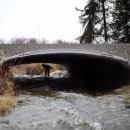States
IndianaThis project will remove three low-head dams along the main channel of the East Fork, Whitewater River in Indiana. These dams are no longer used, are hazardous to people, and harmful to native species of freshwater fish and mussels. This project will benefit 19 fish and 5 mussel species, including freshwater drum, channel catfish, smallmouth bass, river redhorse, logperch and multiple darter species. This work builds on other projects in the area to reconnect all 37 miles of the Whitewater River upstream of the Brookville Reservoir. Removal of these dams will restore the system to a natural condition that is more resilient to changes in climate. The surrounding community will benefit through improved water quality, safer recreation, job creation and more unrestricted access to blue and green spaces
Project Quick Facts:
| Project Status | In Development |
| Location | IN, Wayne County |
| NFPP Project Funding | $650,000 |
| Restoration Techniques | Dam Removal |
| Accomplishments | 4 Stream Miles Reopened |
| Project Partner Lead | Flatland Resources |
The National Fish Passage Program combines technical expertise with a track record of success.
Implemented primarily through the Service's Fish and Wildlife Conservation Offices, the National Fish Passage Program provides financial and technical assistance to partners across the country. Since 1999, the program has worked with over 2,000 local communities, Tribes, and private landowners to remove or bypass over 3,400 barriers to fish passage fish passage
Fish passage is the ability of fish or other aquatic species to move freely throughout their life to find food, reproduce, and complete their natural migration cycles. Millions of barriers to fish passage across the country are fragmenting habitat and leading to species declines. The U.S. Fish and Wildlife Service's National Fish Passage Program is working to reconnect watersheds to benefit both wildlife and people.
Learn more about fish passage and reopen access to over 61,000 miles of upstream habitat for fish and other animals. Staff have expertise in fish migration and biology as well as financial, engineering, and planning assistance to communities, Tribes, and landowners to help them remove barriers and restore rivers for the benefit both fish and people.
Fish passage project proposals can be initiated by any individual, organization, government, or agency. However, proposals must be submitted and completed in cooperation with a Fish and Wildlife Conservation Office. (Please note that fish passage projects being used for federal or state compensatory mitigation or required by existing federal or state regulatory programs are not eligible for funding through the National Fish Passage Program.)
CONTACT A FISH PASSAGE COORDINATOR IN YOUR AREA TO GET STARTED.

